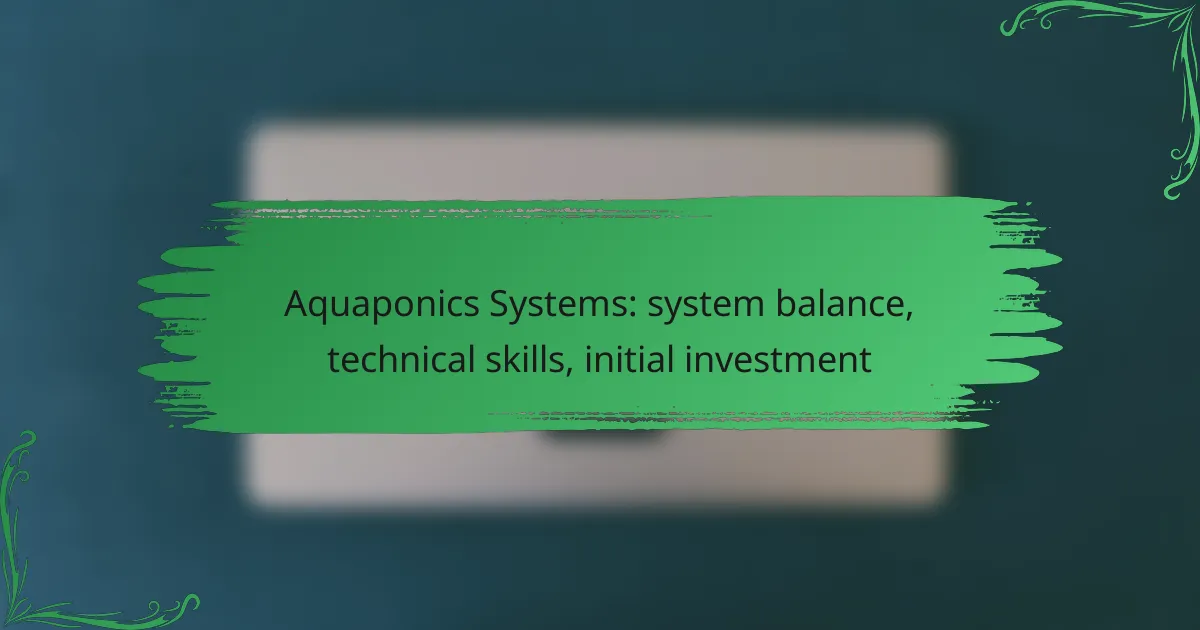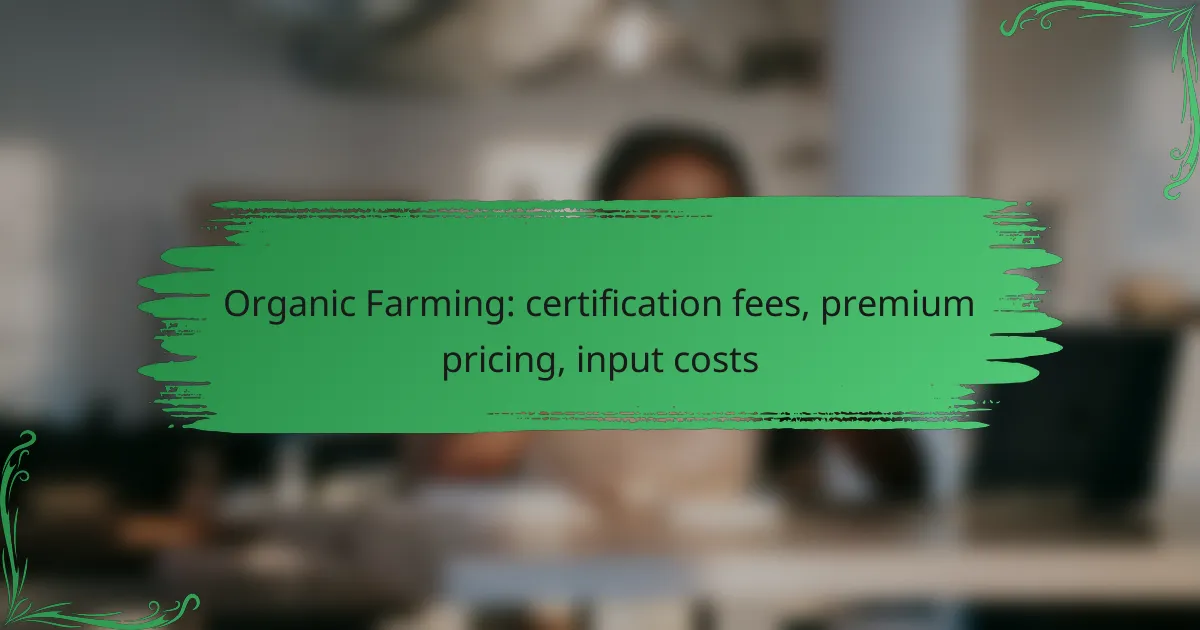Aquaponics systems offer a sustainable solution for urban food production by efficiently utilizing limited space and resources. Achieving a successful balance between fish, plants, and beneficial bacteria is crucial for nutrient cycling and healthy growth. To operate these systems effectively, one must possess technical skills in plumbing, fish care, and plant cultivation, ensuring a thriving ecosystem.
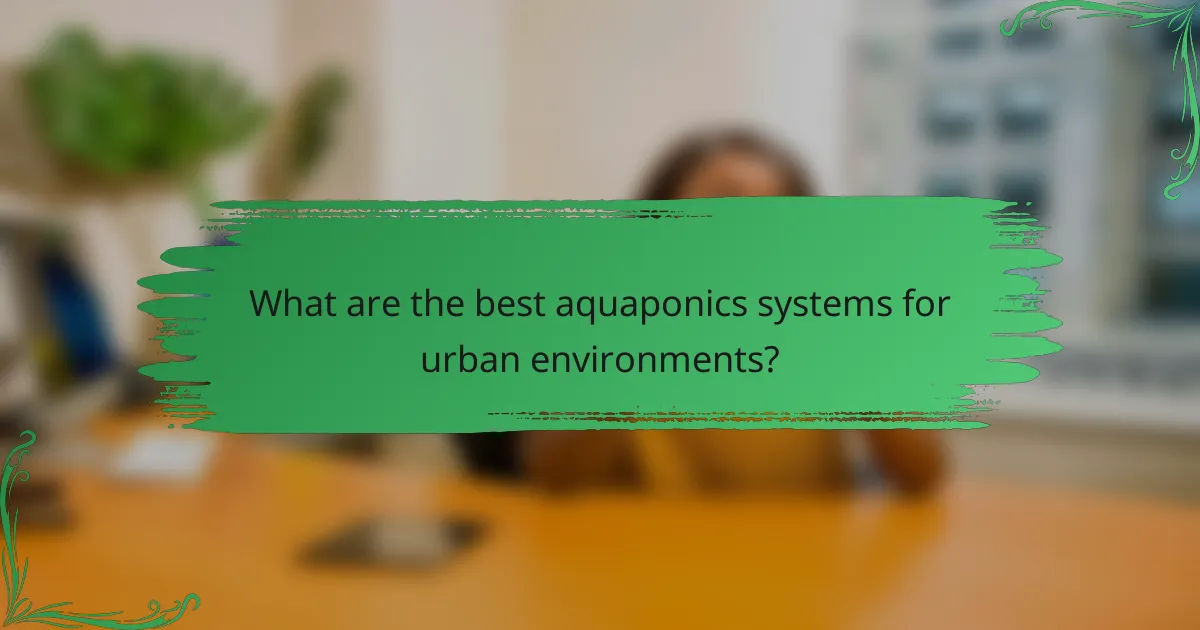
What are the best aquaponics systems for urban environments?
The best aquaponics systems for urban environments are those that maximize space efficiency and minimize resource use. Vertical, container, and modular systems are particularly suited for urban settings, allowing for sustainable food production in limited areas.
Vertical aquaponics systems
Vertical aquaponics systems utilize vertical space to grow plants, making them ideal for urban environments where land is scarce. These systems often incorporate stacked growing beds or towers, allowing for a higher yield per square meter compared to traditional horizontal setups.
When considering a vertical system, look for options that are easy to maintain and have efficient water circulation. Many urban growers choose systems that combine hydroponics and aquaculture, ensuring a balanced ecosystem while maximizing vertical space.
Container aquaponics systems
Container aquaponics systems are portable setups that can be placed on balconies, rooftops, or small yards. These systems typically involve repurposed containers like barrels or tubs, which house both fish and plants, creating a compact and efficient growing environment.
For urban dwellers, container systems offer flexibility and ease of management. Ensure that the containers have proper drainage and aeration to support both fish and plant health. Start with small fish species and fast-growing plants to quickly establish a thriving ecosystem.
Modular aquaponics systems
Modular aquaponics systems consist of interconnecting units that can be expanded or customized according to available space. This adaptability makes them suitable for urban settings where space and resources may vary significantly.
When selecting a modular system, consider how easily it can be reconfigured or scaled up. Look for systems that allow for easy integration of additional components, such as extra grow beds or fish tanks, to accommodate future growth. This flexibility can help urban growers adapt to changing needs and preferences over time.
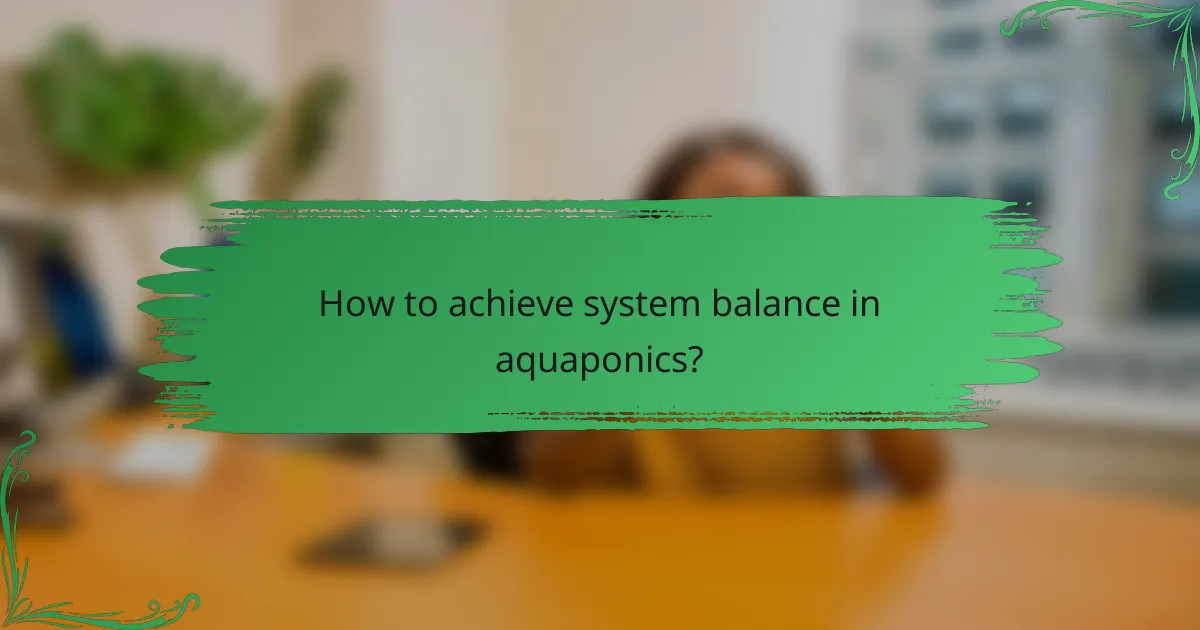
How to achieve system balance in aquaponics?
Achieving system balance in aquaponics involves maintaining a harmonious relationship between fish, plants, and beneficial bacteria. This balance ensures optimal nutrient cycling and healthy growth for both aquatic and terrestrial organisms.
Importance of nitrogen cycle
The nitrogen cycle is crucial in aquaponics as it converts fish waste into nutrients that plants can absorb. Beneficial bacteria break down ammonia from fish excretion into nitrites and then into nitrates, which are vital for plant growth.
To maintain a healthy nitrogen cycle, introduce fish gradually and monitor ammonia levels regularly. A well-established cycle can take several weeks, so patience is essential during the initial setup.
Balancing fish and plant ratios
Balancing the ratio of fish to plants is key to achieving system equilibrium. A common guideline is to have approximately one fish for every two to three plants, depending on the species and growth stage.
Overcrowding fish can lead to excess waste and poor water quality, while too few fish may not provide sufficient nutrients for plants. Adjust ratios based on the size of your system and the specific needs of the fish and plants you choose.
Monitoring water quality
Regular monitoring of water quality is essential for maintaining system balance in aquaponics. Key parameters include pH, ammonia, nitrite, nitrate levels, and temperature, all of which affect the health of fish and plants.
Utilize water testing kits to check these parameters weekly, especially during the initial stages. Aim for a pH between 6.8 and 7.2, and keep ammonia and nitrite levels as low as possible, ideally below 0.5 mg/L. Adjustments may be necessary based on test results to ensure a thriving aquaponics system.
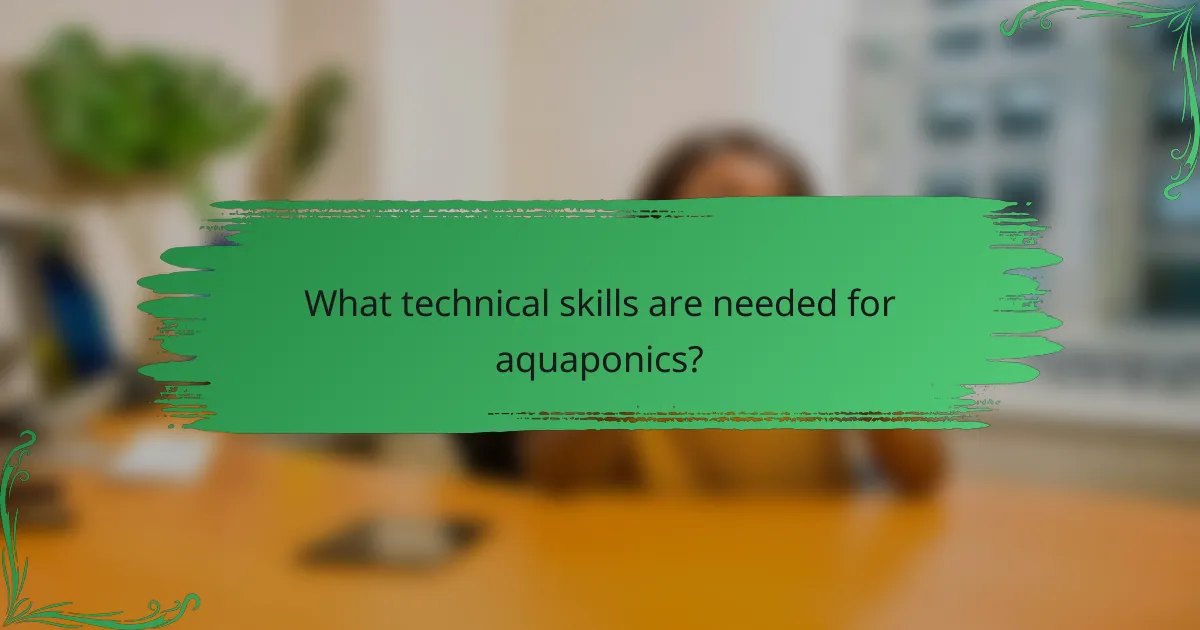
What technical skills are needed for aquaponics?
To successfully operate an aquaponics system, you need a blend of technical skills that include plumbing, fish care, and plant cultivation. Mastering these areas ensures a balanced ecosystem that supports both fish and plants effectively.
Basic plumbing skills
Basic plumbing skills are essential for setting up and maintaining the water flow in an aquaponics system. You should be familiar with installing pipes, valves, and pumps to ensure efficient water circulation. Understanding how to troubleshoot leaks or blockages will help maintain system integrity.
Consider using PVC pipes for their durability and ease of installation. Regularly check connections and seals to prevent water loss, which can impact both fish and plant health.
Understanding of fish care
A solid understanding of fish care is crucial for maintaining a healthy aquaponics environment. This includes knowledge of fish species suitable for aquaponics, their dietary needs, and water quality requirements. Regular monitoring of pH levels, ammonia, and nitrate concentrations is vital for fish health.
Choose fish that are resilient and compatible with your local climate, such as tilapia or catfish. Ensure you provide a balanced diet and observe for signs of stress or disease to keep your fish thriving.
Plant cultivation techniques
Familiarity with plant cultivation techniques is necessary to maximize yield in an aquaponics system. This involves understanding how to select appropriate plants, manage nutrient levels, and implement pest control strategies. Knowledge of hydroponic growing methods can also be beneficial.
Start with easy-to-grow plants like lettuce or herbs, which can thrive in aquaponics. Regularly assess plant growth and adjust nutrient inputs based on visual cues or soil tests to optimize health and productivity.
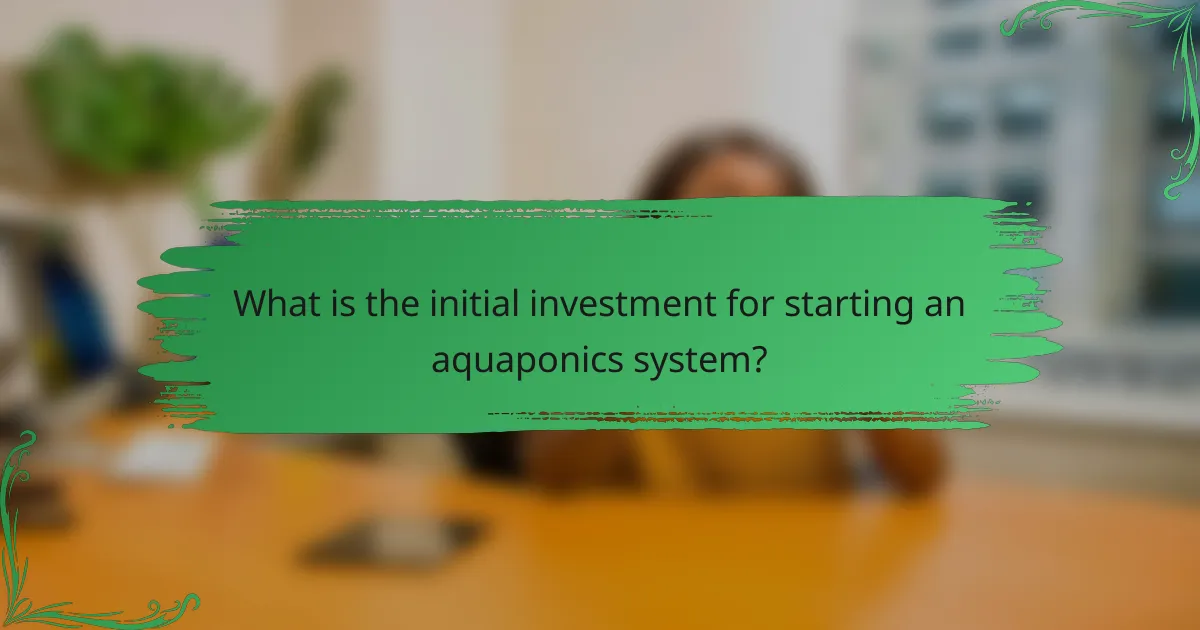
What is the initial investment for starting an aquaponics system?
The initial investment for starting an aquaponics system can vary significantly based on the scale and complexity of the setup. Generally, costs range from a few hundred to several thousand dollars, depending on equipment, materials, and system design.
Cost of equipment and materials
To establish an aquaponics system, you will need essential equipment such as tanks, pumps, grow beds, and filtration systems. Basic setups can start around $500, while more advanced systems can exceed $5,000. Consider factors like the size of your operation and whether you will use new or second-hand materials.
Additionally, you may need to invest in seeds, fish, and water quality testing kits. These costs can add up, so it’s wise to create a detailed budget before starting.
Ongoing maintenance expenses
Ongoing maintenance expenses for an aquaponics system typically include electricity, water, fish feed, and replacement parts. Monthly costs can range from $50 to several hundred dollars, depending on system size and local utility rates.
Regular monitoring and maintenance of water quality and system components are crucial. Neglecting these can lead to higher costs due to system failures or fish loss.
Potential return on investment
The potential return on investment (ROI) for aquaponics can be attractive, especially if you sell produce and fish locally. Many growers report ROI within a year or two, depending on market demand and operational efficiency.
To maximize profits, consider diversifying your product offerings and establishing a strong customer base. Local farmers’ markets or restaurants can be excellent outlets for your fresh produce and fish.
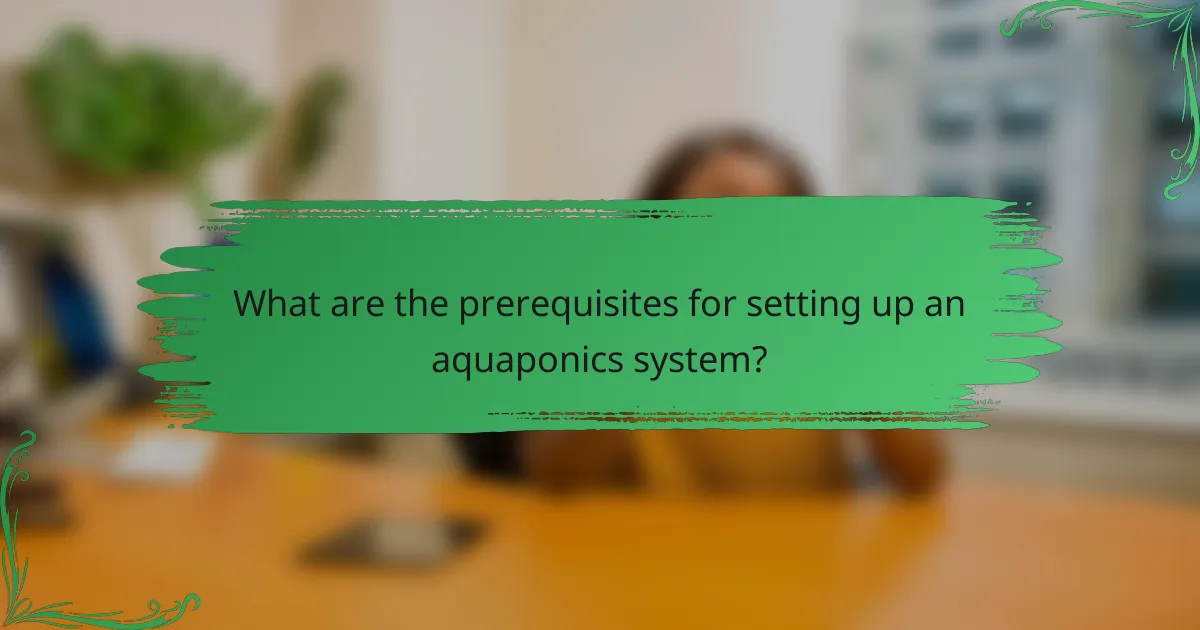
What are the prerequisites for setting up an aquaponics system?
Setting up an aquaponics system requires careful consideration of space, water availability, and local regulations. Understanding these prerequisites will help ensure a successful and sustainable operation.
Space requirements
Aquaponics systems can vary significantly in size, from small home setups to large commercial operations. Generally, a minimum of 10 square meters is recommended for a basic system, allowing for adequate space for fish tanks, grow beds, and necessary equipment.
When planning your space, consider the layout for easy access and maintenance. Vertical systems can maximize space efficiency, especially in urban environments where horizontal space is limited.
Water source availability
Reliable water supply is crucial for aquaponics systems, as both fish and plants depend on it. Ideally, you should have access to clean, treated water that is free from harmful chemicals. Rainwater harvesting can be a sustainable option if local regulations permit.
Assess the quality of your water source regularly, as fluctuations in pH and contaminants can affect system balance. A water testing kit can help monitor these parameters effectively.
Local regulations and permits
Before establishing an aquaponics system, check local regulations regarding water use, fish farming, and food production. Some areas may require permits for operating aquaculture systems, especially if you plan to sell produce commercially.
Understanding zoning laws is also important, as certain locations may have restrictions on agricultural activities. Engaging with local agricultural extensions or aquaponics associations can provide valuable insights into compliance and best practices.

How does aquaponics compare to traditional farming?
Aquaponics offers a more sustainable alternative to traditional farming by integrating fish and plant cultivation in a symbiotic environment. This method reduces water usage and eliminates the need for chemical fertilizers, making it an eco-friendly choice for food production.
Resource efficiency
Aquaponics systems are highly resource-efficient, using up to 90% less water than conventional farming methods. The closed-loop system recycles water between fish tanks and plant beds, minimizing waste and conserving resources.
Additionally, aquaponics eliminates the need for synthetic fertilizers, as fish waste provides essential nutrients for plants. This natural fertilization process not only reduces costs but also promotes healthier plant growth.
Yield comparison
Yields from aquaponics can be comparable to or even exceed those of traditional farming, depending on the crops grown and system management. For instance, leafy greens and herbs often thrive in aquaponic setups, allowing for multiple harvests within a year.
However, achieving optimal yields requires technical skills in managing both fish and plant health. Beginners should start with simpler crops and gradually expand their system as they gain experience to maximize productivity.
